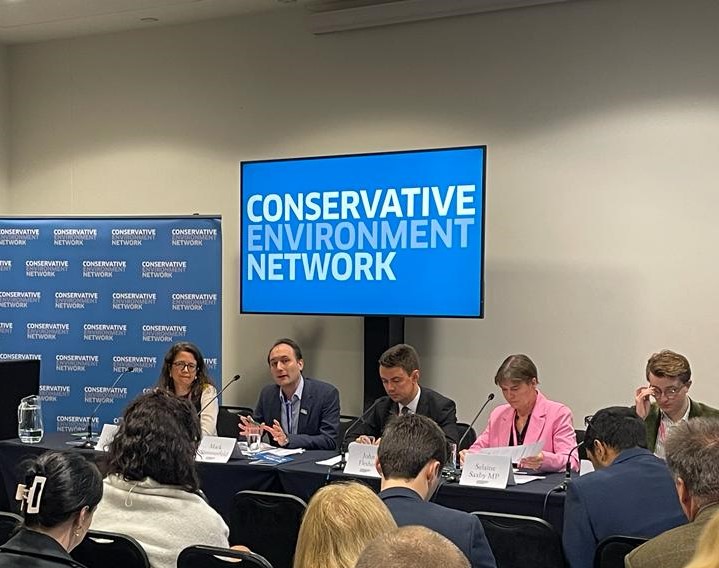
Subsidies are given to biomass plants, including those powered by waste wood, as part of the government’s Renewables Obligations Certificates scheme.
Under this system biomass facilities, including those funded by waste wood, which entered commissioning before September 2018 are given a subsidy for the electricity generated. This is due to run until 2027.
The subsidy has proved controversial as some say it encourages the cutting down of trees to use as energy, a point raised throughout the panel. For waste wood however, the idea is that is uses waste which previously went to landfill, though this has still proved controversial in some quarters (see letsrecycle.com story).
Statistics suggest around 2.7 million tonnes of waste wood was sent to biomass plants in 2022, accounting for 63% of total material processed.
Scrapped
In the discussion on Tuesday (3 October) the panel, hosted by the Conservative Environment Network, discussed the future of subsidies during the talk named: ‘Is burning wood for electricity a waste of taxpayers’ money’.
The panel included Maxwell Marlow of the Adam Smith Institute, the MP for North Devon Selaine Saxby, Mark Sommerfield, of the Renewable Energy Association (REA) and Kate Norgrove from the WWF.
While the panel regularly hit out at the government’s funding of the biomass industry, particularly naming Drax, the REA’s Mr Sommerfield was eager to provide context.
He said: “When we say the government is subsidising the industry, we mean that the existing fleet of bioenergy biomass sites were supported through the renewable obligation through the 2020s and some contracts for difference, the very first of them.
“In the last four there have been no subsidies for new plants, the sector is not looking to build more plants, the existing subsidies for unabated biomass will start to end in 2027. That is the investment that the government put in place to ensure we have a viable bioenergy sector.
“So when talking about subsidy, it is not a case we are throwing it at biomass when it should be other things. I agree we need to be doing an awful lot more wind and solar, but these work in a energy system. Biomass provides baseload capacity, it provides grid security when other renewables can’t do that for obvious reasons. It is about building a system.”.
On waste, as outlined below, Mr Sommerfield highlighted that it should be the lowest value wood, which ends up in biomass. “Biomass allows low value product to have a use in that circular economy, and providing additional revenue streams,” he said.
🗣️ Mark Sommerfeld: “You can’t use a whole tree to build a house, there is a lot of waste."
"All of this [biomass] is using the forest effectively and efficiently. And all the lowest quality wood goes to bio-energy. It is providing additional revenue on top of that revenue.” pic.twitter.com/Zr7Ap2BuQ2
— Conservative Environment Network (@CEN_HQ) October 3, 2023
Subsidies
The use of subsidies however was heavily criticised by the rest of the panel, with calls for them to be stopped.
Maxwell Marlow said the subsidiaries are “distortive” and “hold back” scientific advancement, and added business will “kickstart itself without government intervention”.
He was backed up in the panel discussion by Selaine Saxby MP who said the science “has moved on from where we started”.
She said: “We need to burn wood at the moment, it is 6% of our energy supply, but I don’t think we should be subsidising it. I don’t think we should be subsiding, what is increasingly being proven by the science, not the politicians, that this is a polluting form of energy.”
She added: “I have a real issue of the level of subsidy here, when other far more renewable sources have not received the same level of support. We have to follow the science here.”
On waste however, she used the example of forestry waste as a way biomass can be used. Ms Saxby said: “Waste wood is an interesting one. I think we really need to look at whole cycles. So, when we talk about circular economies, I think the same can be said for trees, how do we ensure we optimise carbon from a free? It is pointless leaving waste”.
Waste wood is an interesting one. I think we really need to look at whole cycles
- Selaine Saxby MP
Carbon capture
The REA’s Mr Sommerfield later outlined that looking forward, the focus of the industry is on bioenergy with carbon capture and storage (BECCS). He said the industry is fully on board on ensuring this is done correctly.
“The biomass strategy highlighted that by 2050, the government wanted BECCS to be the primary source of energy.”
He added: “We do not assume it is carbon negative or neutral, but if done correctly it can be those things. That is crucially important.”
However, this was dismissed by the WWF’s Kate Norgrove, who said: ” BECCS might not deliver carbon negative solutions if burning wood from forests. This just allows organisations to keep polluting in the certainty we can capture it in the future and it’s a massive gamble. We should not be subsidising biomass in any way. We don’t have to be spending billions on subsiding the industry.”
Waste wood biomass plants do not use virgin forestry wood and process for energy a large amount of material which those in favour say was previously sent to landfill.
However, any move to scrap the ROCs subsidy would impact the viability of facilities.










Subscribe for free